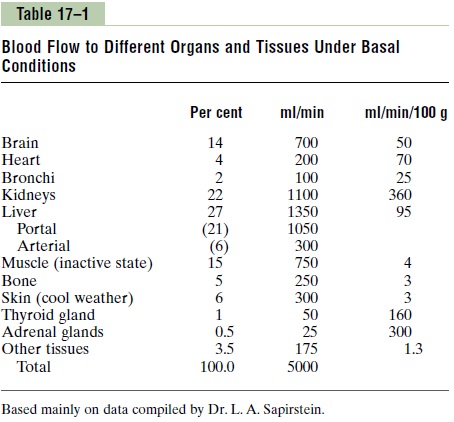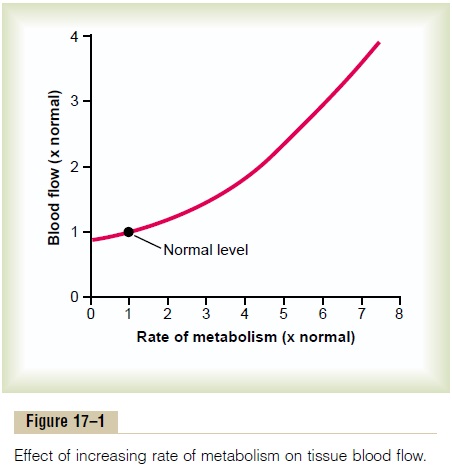Chapter: Medical Physiology: Local and Humoral Control of Blood Flow by the Tissues
Local Control of Blood Flow in Response to Tissue Needs
Local Control of Blood Flow in Response to Tissue Needs
One of the most fundamental principles of circula-tory function is the ability of each tissue to control its own local blood flow in proportion to its meta- bolic needs.
What are some of the specific needs of the tissues for blood flow? The answer to this is manyfold, including the following:
o Delivery of oxygen to the tissues
o Delivery of other nutrients, such as glucose, amino acids, and fatty acids
o Removal of carbon dioxide from the tissues
o Removal of hydrogen ions from the tissues
o Maintenance of proper concentrations of other ions in the tissues
o Transport of various hormones and other substances to the different tissues
Certain organs have special requirements. For instance, blood flow to the skindetermines heat loss from the body and in this way helps to control body tem-perature. Also, delivery of adequate quantities of blood plasma to the kidneys allows the kidneys to excrete the waste products of the body.
We shall see that most of these factors exert extreme degrees of local blood flow control.
Variations in Blood Flow in Different Tissues and Organs. Note in Table 17–1 the verylarge blood flows in some organs—for example, several hundred milliliters per minute per 100 grams of thyroid or adrenal gland tissue and a total blood flow of 1350 ml/min in the liver, which is 95 ml/min/100 g of liver tissue.

Also note the extremely large blood flow through the kidneys—1100 ml/min. This extreme amount of flow is required for the kidneys to perform their func-tion of cleansing the blood of waste products.
Conversely, most surprising is the low blood flow to all the inactive muscles of the body, only a total of 750 ml/min, even though the muscles constitute between 30 and 40 per cent of the total body mass. In the resting state, the meta-bolic activity of the muscles is very low, and so also is the blood flow, only 4 ml/min/100 g. Yet, during heavy exercise, muscle metabolic activity can increase more than 60-fold and the blood flow as much as 20-fold, increasing to as high as 16,000 ml/min in the body’s total muscle vascular bed (or 80 ml/ min/100 g of muscle).
Importance of Blood Flow Control by the Local Tissues. One might ask the simple ques-tion: Why not simply allow a very large blood flow all the time through every tissue of the body, always enough to supply the tissue’s needs whether the activ-ity of the tissue is little or great? The answer is equally simple: To do this would require many times more blood flow than the heart can pump
Experiments have shown that the blood flow to each tissue usually is regu-lated at the minimal level that will supply the tissue’s requirements— no more, no less. For instance, in tissues for which the most important requirement is delivery of oxygen, the blood flow is always controlled at a level only slightly more than required to maintain full tissue oxygenation but no more than this.
By controlling local blood flow in such an exact way, the tissues almost never suffer from oxygen nutritional deficiency, and yet the workload on the heart is kept at a minimum.

Related Topics